Artists
Arlene Shechet’s Monumental New Works Descend on the ‘Promised Land’ of Sculpture Parks
Her monumental outdoor sculptures are now on view at Storm King in New York's Hudson Valley.
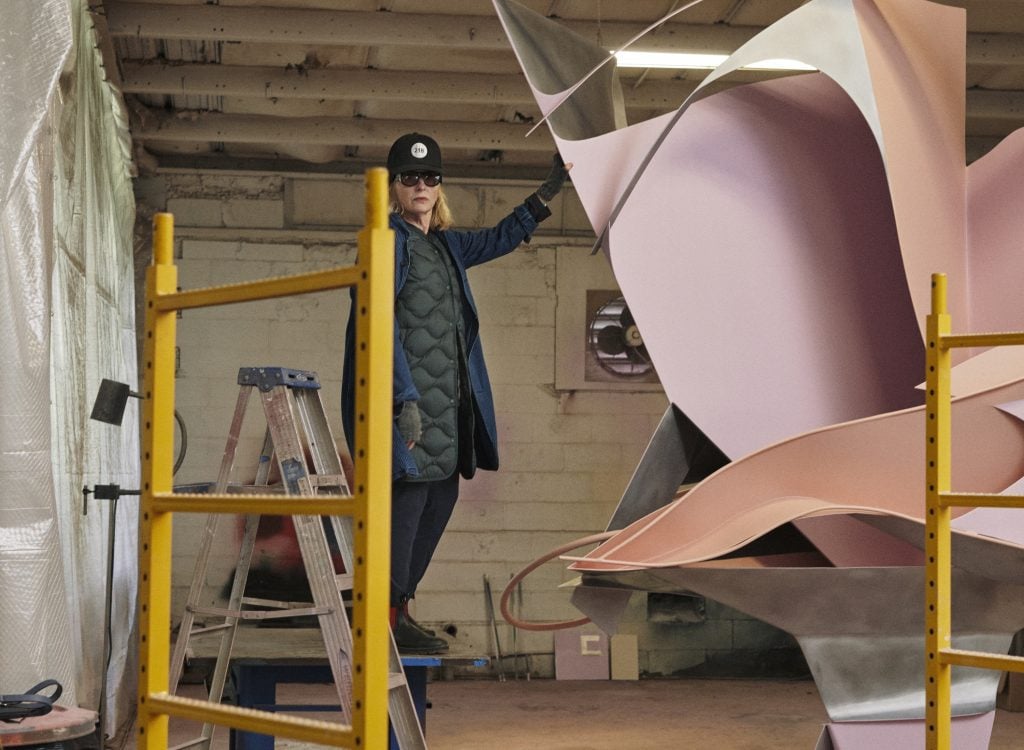
Her monumental outdoor sculptures are now on view at Storm King in New York's Hudson Valley.

Katie White

When asked what has kept her inspired and motivated over her decades-long career, 73-year-old sculptor Arlene Shechet had a refreshingly simple response. “I love being in the studio,” she answered, her voice filling with joy.
The artist, who keeps studios in Woodstock and Kingston, New York, recently opened “Girl Group” an installation of six new towering and colorful outdoor sculptures co-curated by Nora Lawrence and Eric Booker. The works, with names like Bea Blue and Rapunzel, are lyrical and abstract, their stainless-steel forms painted in pale pinks, bright blues, and crisp yellows that pop against the green hills of Storm King Art Center, an open air museum in upstate New York. They’re also some of her largest yet.
After rising to acclaim in the early 2000s with her shape-shifting, materially diverse sculptures and ceramics, Shechet has had her work enter esteemed art collections around the world. She’s no newcomer to creating public artworks, either; in 2018 she debuted her first public art installation with “Full Steam Ahead” an exhibition at Madison Square Park, New York—where she installed monumental porcelain and cast iron works along the park’s walkways.
But the sculptures commissioned for Storm King mark a new scale for the artist: works tower ten to 20 feet in height and stretch up to 30 feet wide. Visitors, too, will find a curation of her recent ceramic creations, for which she is best known, on view in Storm King’s indoor galleries.
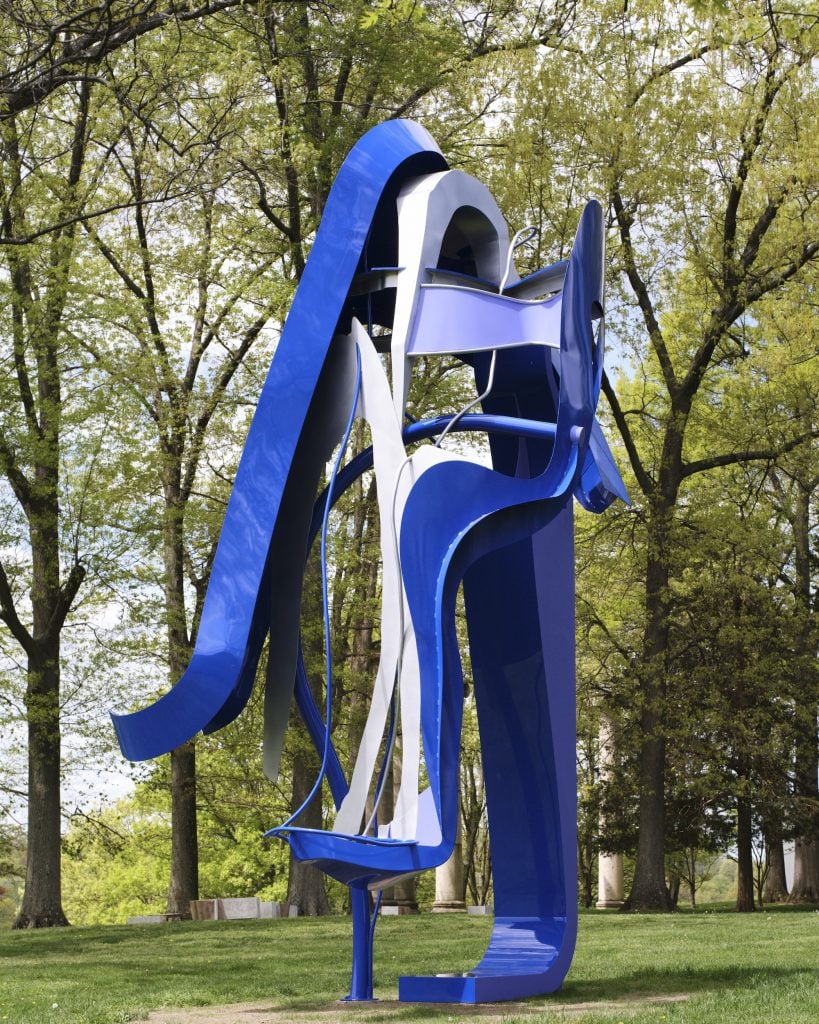
Arlene Shechet, Rapunzel (2024). Courtesy of the Artist and Pace Gallery. Photo by David Schulze.
“The promised land,” is how Shechet described the art center’s importance to sculptors in the lead-up to the opening. In its fruition, “Girl Group” does not memorialize Shechet’s 30-plus year career so much as highlight her as an artist still on the ascendant, still reaching for new creative heights.
“Arlene’s work is bold and audacious, and visitors will certainly feel the pulse of the new sculptures she has created for Storm King across our landscape,” said Lawrence, Storm King’s artistic director and chief curator.
“My art evolution is not a straight line, it’s branching,” Shechet told me in a phone call. Over the decades, Shechet has immersed herself in a range of materials. In the early 1990s, the New York-born artist launched her career with plaster and paint forms whose shapes have drawn parallels to seated Buddhas (Shechet is a student of Eastern philosophies including Buddhism). In 2006, she began work in ceramics, a medium she would redefine for the contemporary moment. For the artist, showing her concurrent ceramics and large-scale sculptures alongside each other is an essential component of the Storm King exhibition, highlighting two concurrent modes of expression.
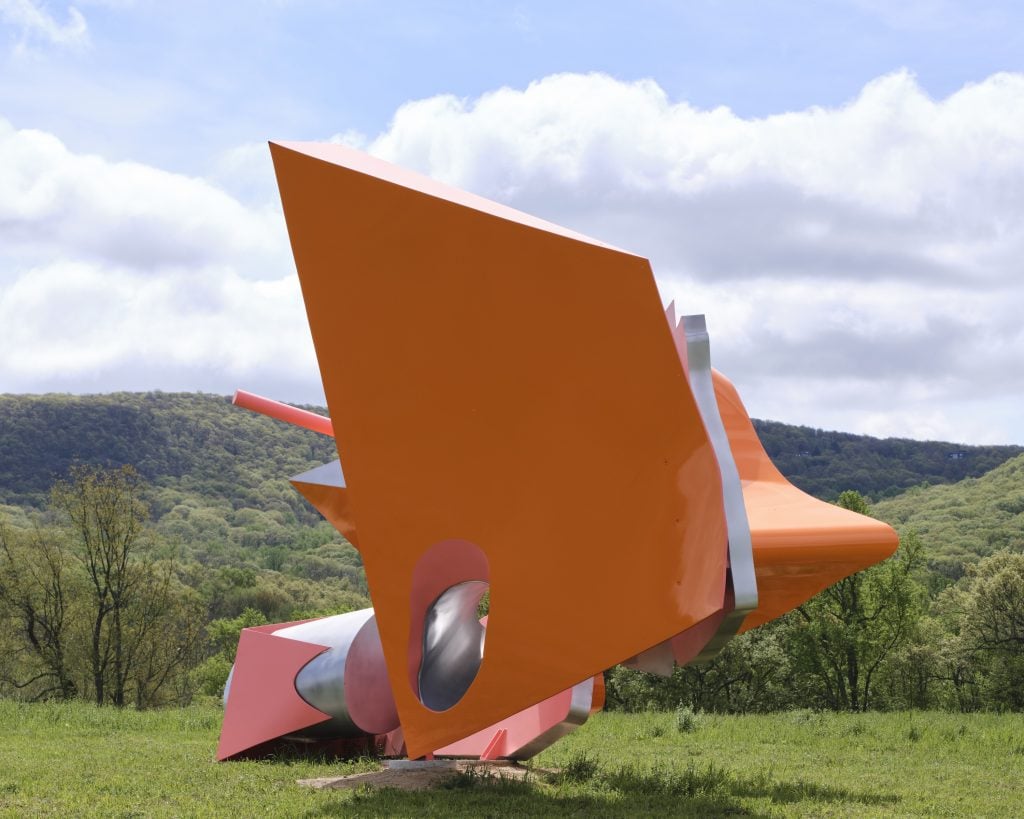
Arlene Shechet, Midnight (2024). Courtesy of the Artist and Pace Gallery. Photo by David Schulze.
“With public art, I wanted the opportunity to speak to different audiences,” she explained. Too often people have tried to confine her practice to restrictive phases, she believes. “It’s not that I worked in ceramics and now I only do colored steel,” she said. “That narrative is trying to keep me in my lane. It is a narrow view. I can do more than one thing.“
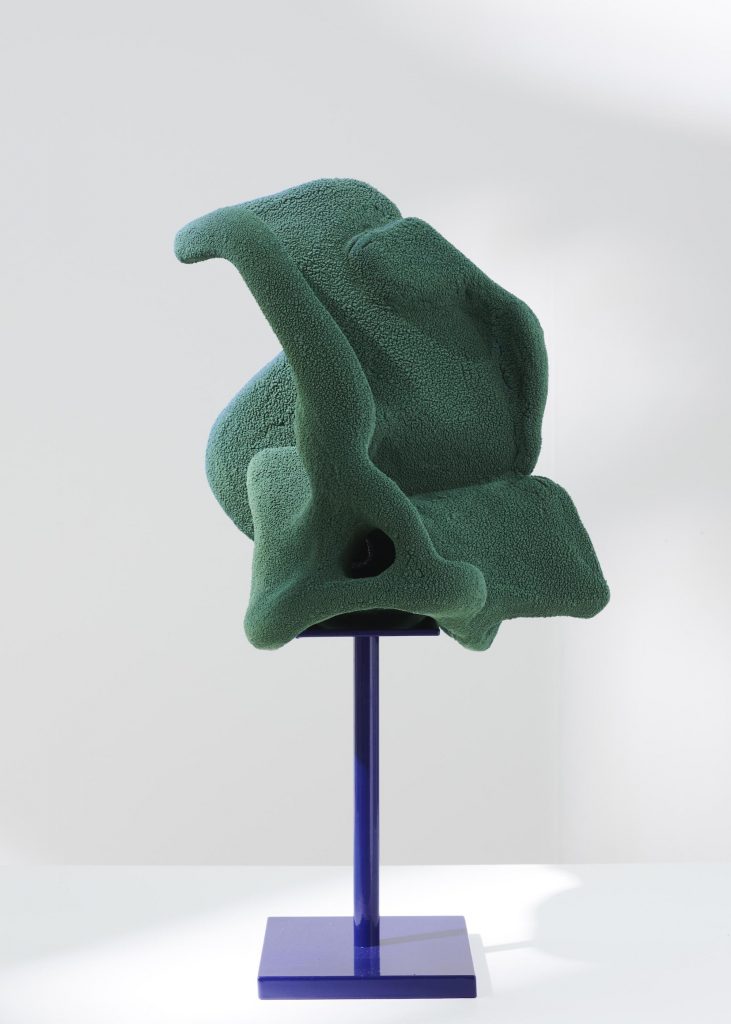
Arlene Shechet, Emerald Green (2024). Courtesy of the Artist and Pace Gallery. Photo by David Schulze.
What the Storm King works—from intimately scaled ceramics to monumental stainless-steel forms—share most notably is a profound sense of color, The ceramics often exude deeper hues—emerald greens and navy—while the outdoor sculptures are brighter, delicate shades. For the six outdoor sculptures, Shechet had painted each in two similar colors (periwinkle blue and royal blue for instance) while leaving areas of stainless steel exposed. These nuanced studies in color stand in contrast to the preponderance of monochromatic white, black, and occasionally red sculptures that otherwise dominate the park. The sculpture, As April, for instance, painted both a pastel and a bright yellow, calls to mind an abstract daffodil nudging its head up through the ground. Her studies of color are serious, but the work itself never becomes self-serious.
“Color is something I feel in my body. It’s not an intellectual thing. That’s one of the reasons I love it, because color is a great communicator body to body with other people,” Shechet said. “One of the reasons, I became interested in ceramics was because I could glaze the clay and the color could saturate the material. In the firing, the color becomes part of the material structure.”
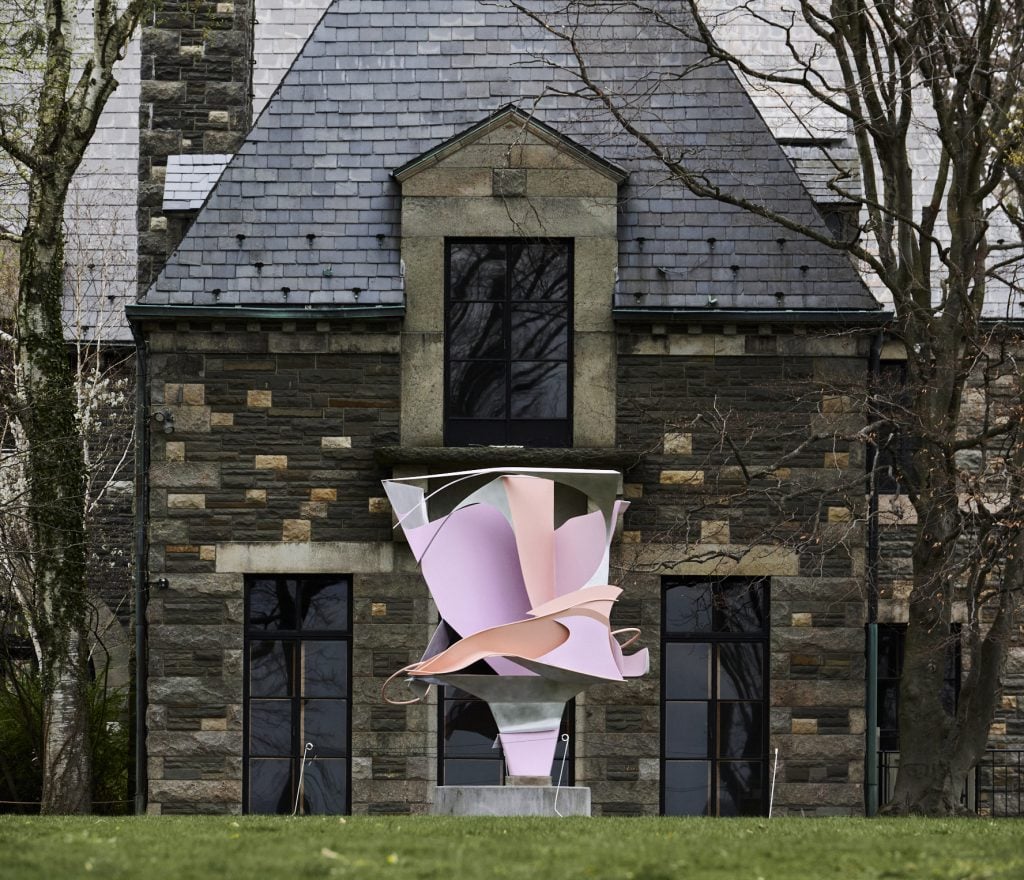
Arlene Shechet, Dawn (2024). Courtesy of the Artist and Pace Gallery. Photo by David Schulze.
A sense of shifting, or slippage, is core to Shechet’s artistic aims. “I’ve painted each outdoor sculpture two colors, one with a glossy finish, and one matte. As you walk around the sculpture the colors change. That’s one of the delights of working outside, those shifts,” she said. Her titles—Rapunzel, Midnight, Maiden May—suggest a polyphony of narratives too, referencing women’s names and times of day often at once. “Words are a material to me. I love folding words into the work, but I want them to remain slippery, to slide into multiple associations,” she said.
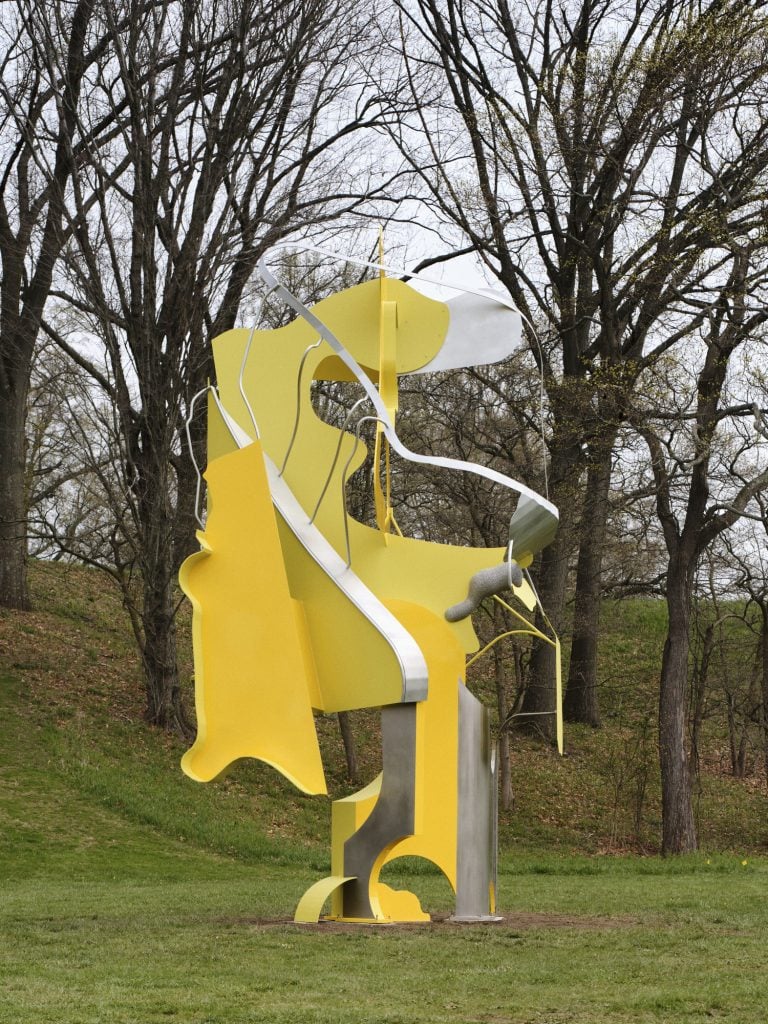
Arlene Shechet, As April (2024). Courtesy of the Artist and Pace Gallery. Photo by David Schulze.
In describing her intentions with “Girl Group,” Shechet often returned to the word “generous.” She wants visitors to feel invited to interact with the work and not to get caught up in jargon. “People come to Storm King and use it as a park. This is not always the same population of people who go to museums and galleries,” she explained, “Ultimately, people don’t need to read a paragraph about my work to understand what I’m doing.” Visitors are welcome to bring to Shechet’s work what they may.
To create a more welcoming environment, Shechet has designed benches that have been installed for viewing the works, or just for sitting (Shechet also added benches to her 2021 exhibition at the Drawing Center). “The benches are also very practical. There are never enough places to sit down. It doesn’t have to be so purposeful,” she said. “I want to signal that I respect you, I care about you.”